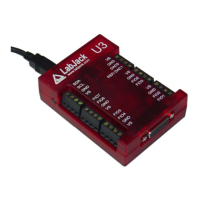Parameter Conditions Min Typical Max Units
Analog Inputs
Typical Input Range (1) Single-Ended
Differential -2.44
0 2.44 volts
2.44 volts
Special 0-3.6 0 3.6 volts
Max AIN Voltage to GND (2) Valid Operation -0.3 3.6 volts
Max AIN Voltage to GND (3) No Damage, FIO -10 10 volts
No Damage, EIO -6 6 volts
Input Impedance (4) 40 MΩ
Source Impedance (4) LongSettling Off 10 kΩ
LongSettling On 200 kΩ
Resolution (No Missing Codes) 12 bits
Integral Linearity Error ±0.05 % FS
Differential Linearity Error ±1 counts
Absolute Accuracy Single-Ended ±0.13 % FS
Differential ±0.25 % FS
Special 0-3.6 ±0.25 % FS
Temperature Drift 15 ppm/°C
Noise (Peak-To-Peak) (5) QuickSample Off ±1 counts
QuickSample On ±2 counts
Effective Resolution (RMS) (6) QuickSample Off >12 bits
Noise-Free Resolution (5) QuickSample Off 11.0 bits
Single-Ended 1.2 mV
Diff., Special 2.4 mV
Command/Response Speed See Section 3.1
Stream Performance See Section 3.2
(5) Measurements taken with AIN connected to a 2.048 reference (REF191 from Analog Devices). All "counts" data are
aligned as 12-bit values. Noise-free data is determined by taking 128 readings and subtracting the minimum value from the
maximum value.
(6) Effective (RMS) data is determined from the standard deviation of 128 readings. In other words, this data represents
most
readings, whereas noise-free data represents
all
readings.
(1) With DAC1 disabled.
(2) This is the maximum voltage on any AIN pin compared to ground for valid measurements. Note that a differential
channel has a minimum voltage of -2.44 volts, meaning that the positive channel can be 2.44 volts less than the negative
channel, but no AIN pin can go more than 0.3 volts below ground.
(3) Maximum voltage, compared to ground, to avoid damage to the device. Protection level is the same whether the device
is powered or not.
(4) The analog inputs essentially connect directly to a SAR ADC on the U3, presenting a capacitive load to the signal source.
The key specification is the maximum source impedance. As long as the source impedance is not over this value, there will
be no additional errors do to impedance problems.
117

